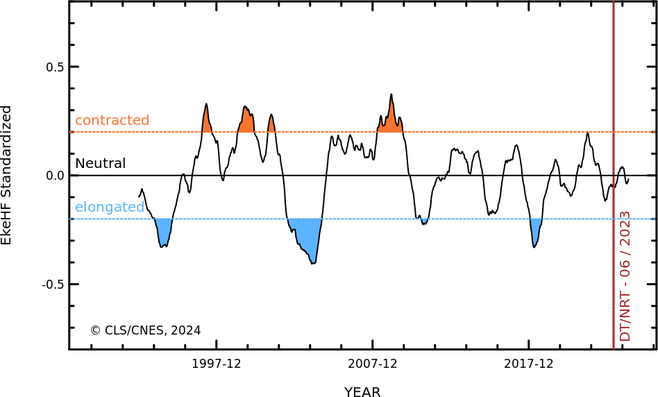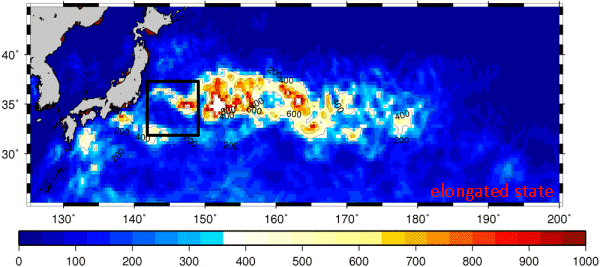Kuroshio
The Kuroshio Extension is characterized by a strong variability. This variability results in two rather different states of the Kuroshio Extension: an "elongated state" corresponding to a narrow strong steady jet vs a "contracted state" in which the jet is weaker and more unsteady, spreading on a wider latitudinal band. Between these two main states, the Kuroshio Extension has many neutral states of transition and presents either progressively weakening or strengthening trends. An indicator based on the high-frequency eddy kinetic energy (EKE) well checks these Kuroshio Extension states.
So note that since April 2022, a new version taking in account DUACS DT2021 has been implemented as described here
Standardized Eddy Kinetic Energy (EKE) over the Kuroshio region. Blue shaded areas correspond to elongated states periods (1993-94, 2002-04 and 2010-11), while orange shaded areas fit contracted states periods (1997-2001 and 2009). See also non-standardized figure.
The Kuroshio Extension is an eastward-flowing current in the subtropical western North Pacific after the Kuroshio separates from the coast of Japan at 35°N, 140°E. Being the extension of a wind-driven western boundary current, the Kuroshio Extension is rich in large-amplitude meanders and energetic eddies. The Kuroshio Extension region has the largest sea-surface height variability on sub-annual and decadal time scales in the extratropical North Pacific Ocean. Prediction and monitoring of the path of the Kuroshio is of huge importance for local economies as the position of the Kuroshio strongly determines the regions where phytoplankton and hence fish are located.
Two rather different states of the Kuroshio extension are observed: an "elongated state" (also called "strong state") corresponding to a narrow strong steady jet, and a "contracted state" (also called "weak state") in which the jet is weaker and more unsteady, spreading on a wider latitudinal band. When the Kuroshio Extension jet is in a contracted (resp. elongated) state, the upstream Kuroshio Extension path tends to become more (resp. less) variable and regional eddy kinetic energy level tends to be higher (resp. lower). [Bessière et al, 2012] show that, to monitor both those states, an average over a box located between 142-149°E and 32-37°N of the high-frequency eddy kinetic energy is a good indicator of Kuroshio extension variations.
On the graph above, blue shaded areas correspond to elongated states periods (1993-94, 2002-04 and 2010-11), while orange shaded areas fit contracted states periods (1997-2001 and 2009). For each year of the orange and blue shaded periods the yearly path always matches one of the two patterns. Between these two opposite phases the Kuroshio Extension jet has many intermediate states of transition and presents either progressively weakening (1994-97 and 2004-2009) or strengthening (2001-2002 and 2009-2010) trends.
Download:
The access to this product is direct via: https://data.aviso.altimetry.fr/aviso-gateway/data/indicators/kuroshio/
For more information:
- Image of the Month, March 2012: Following Kuroshio paths
- Image of the Month, January 2005: Current heat
- Applications: Boundary current: the Gulf Stream and the Kuroshio
References (and details of the computation)
- Bessières, L., M.H. Rio, C. Dufau, C. Boone, M.I. Pujol, 2012: Ocean state indicators from MyOcean altimeter products, Ocean Sciences, doi:10.5194/osd-9-2081-2012







